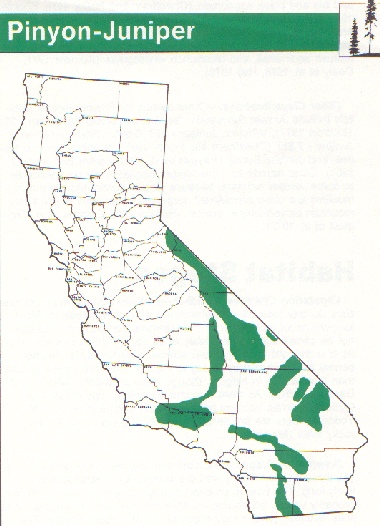Tree Dominated Wildlife Habitats
Pinyon-juniper Woodland
(PJN) Pinyon Species, Juniper Species, Mountain Mahogany SpeciesAt middle elevations across the Mojave and nearby ranges, pinyon pines and junipers form scattered woodlands on rocky slopes and ridges. Trees are usually small and round-topped, rarely more than 30–50 feet tall, with plenty of open space between them. Beneath the trees grow shrubs such as sagebrush, blackbrush, and mountain mahogany, along with grasses like Indian ricegrass and western wheatgrass.
This woodland supports a wide variety of wildlife. Pinyon jays, woodrats, mice, and chipmunks depend on the rich food supply of pinyon nuts and juniper berries. In turn, these animals help spread the seeds. Lizards, snakes, and larger mammals such as bighorn sheep and mountain lions also roam these habitats.
Pinyon-juniper woodlands often sit between desert scrub below and pine forests above, making them a transition zone. They grow best where rainfall is about 12–18 inches per year, though they can survive on less. These trees grow very slowly—some pinyons can live over 1,000 years—so the woodlands you see today are often many centuries old.
Pinon-juniper Woodland Summary

State of California
Rodents - Death Valley Wildlife
Colorful squirrel; pinyon-juniper woodlands of Panamint and Grapevine Mountains; active nearly year-round. White-tailed Antelope Squirrel ...
Desert Ecosystems
Pinyon-Juniper Woodland - Desert Habitats ... This habitat includes sagebrush, goldenbush, wildflowers such as Indian paintbrush, and Mojave prickly pear . ...
Lizards - Death Valley Wildlife
Sagebrush through pinyon-juniper woodlands to 10500 feet. Side-blotched Lizard Uta stansburiana Most commonly seen lizard in park; throughout park below ...
Natural Science: Joshua Tree
And it represents the only kind of woodland forest found in the park. In late summer and early fall ... < Previous - Next >, Pinyon juniper woodland habitat ...
Native American Culture - Death Valley National Park
... through Joshua Tree and pinyon-juniper woodlands, to higher elevations of mixed pine and ... often located at a border between scrub or woodland zones. ...
Lizards - Desert Wildlife
Sagebrush through pinyon-juniper woodlands to 10500 feet. Desert Night Lizard Xantusia vigilis vigilis Under debris of yuccas; sagebrush zone of Panamint ...
Red Rock Canyon Desert Plant Communities
Pinyon-juniper Woodland This habitat includes sagebrush, goldenbush, wildflowers such as Indian paintbrush, and Mojave prickly pear cactus. Also look for . ...
Desert Reptiles and Amphibians
Found in rocky areas, creosote brush and pinyon-juniper. ... Found in varied habitats, from barren desert to woodland. Mojave Glossy Snake (Arizona elegans ...
Skull Rock Nature Trail
Cactus-Yucca Scrub Habitat · Desert Wash · Joshua Tree Woodland · Pinyon-Juniper Woodland, ...
Inyo Mountains Wilderness
Vegetation includes creosote, shadscale scrub, big sagebrush, lush riparian areas in most of the canyons on the eastern slope and pinyon-juniper woodland, ...
Big Morongo Canyon Preserve
Dry slopes are characterized by low creosote brush scrub at lower elevations, and pinyon-juniper woodland at higher elevations. ...
Antelope Squirrel - Desert Wildlife
The males play no role in the rearing of the young.
Wildrose Charcoal Kilns - Death Valley National Park
Panamint Range, the area also displays features of the Saline Valley - Cottonwood Mountains region, specifically, Pinyon-Juniper Woodland habitat. ...
Long-nosed Snake Rhinocheilus lecontei - Desert Snakes
Western Long-nosed Snake Rhinocheilus lecontei lecontei Creosote bush scrub and pinyon-juniper woodlands (common) Desert Patch-nosed Snake . ...
Mammals: Joshua Tree National Park Wildlife
Rodents Dusky Chipmunk Tamias obscurus davisi pinyon-juniper woodlands (common) ... pinyon-juniper woodlands (uncommon) Desert Grasshopper Mouse ...
Western Scrub Jay - Birds, Wildlife in the Mojave Desert
Water dependence of birds in a temperate oak woodland. ... True to their name, Western Scrub Jays inhabit areas of low scrub, preferring pinyon-juniper ...
Death Valley Wildlife
... mesquite at the lower elevations and range up through shadscale, blackbrush, Joshua tree, pinyon-juniper woodlands, to limber pine and bristlecone pine. ...
Hidden Valley: A Relict Population
Before that, pinyon-juniper woodlands covered the lower slopes of the present desert ranges and basins. As the climate became more arid, this conifer ...